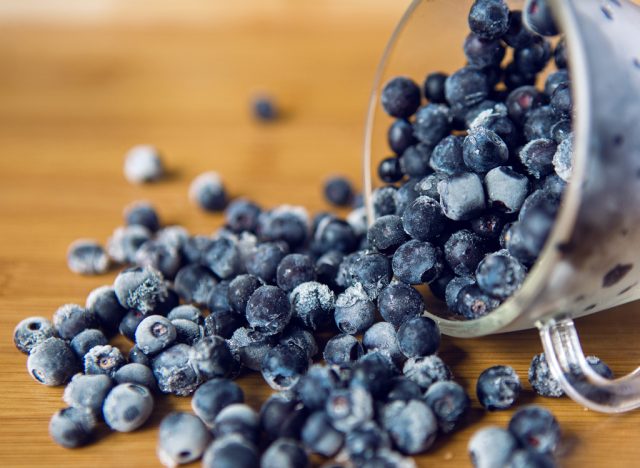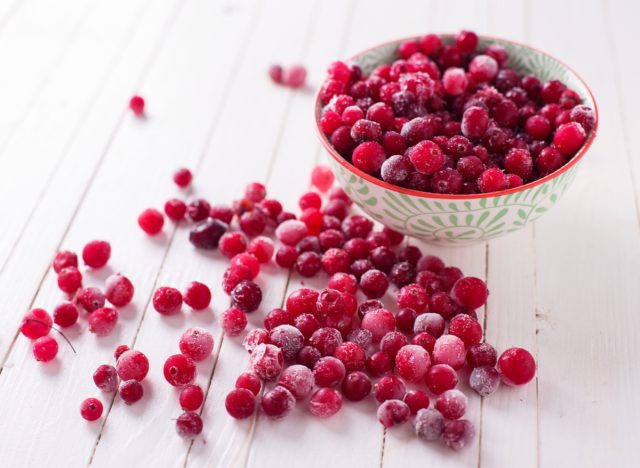The Best Frozen Foods to Decrease Inflammation, Says Dietitian

It’s now well known, thanks to thousands of research articles, that chronic low-grade inflammation increases your risk for myriad health conditions including heart disease, stroke, diabetes, arthritis, lupus, and even dementia. One of the best ways to combat chronic inflammation is with diet and exercise, including keeping your weight in check.
An anti-inflammatory diet is based on primarily eating plant-based foods while also limiting added sugars, refined foods, and animal-based foods that are high in saturated fat.
Read on for four anti-inflammatory foods that you can find in the freezer aisle, and for more on how to eat healthy, don’t miss The #1 Best Juice to Drink Every Day, Says Science.
Frozen wild blueberries

Next time you’re in the frozen aisle, you’ll want to pick up these little blue-hued gems. That’s because they’re packed with flavor and compounds known as anthocyanins that give them their dark blue color.
Studies show that anthocyanins can help to decrease inflammation implicated in many chronic diseases, such as heart disease, type 2 diabetes; neurogenerative conditions; and some types of cancer. Wild blueberries have 33% more anthocyanins than ordinary blueberries.
Wild blueberries are never planted—they grow wild and are picked at the peak of ripeness ensuring that all the health and flavor benefits are locked in. Add them to your cereals, salads, and yogurt to boost taste and nutrition!
Frozen salmon

Among the top inflammation fighters are essential fatty acids called omega-3s – particularly those found in salmon and other fatty fish called eicosapentaenoic acid (EPA) and docosahexaenoic acid (DHA). Omega-3s can help control immune system cells and enzymes known as cytokines, which both drive up the inflammatory response.
Studies show that EPA and DHA can help reduce pain and inflammation in rheumatoid arthritis, while early research indicates that fish-based omega-3s may be useful in treating inflammatory conditions including lupus, psoriasis, multiple sclerosis, and even asthma. Frozen salmon is a healthy, more affordable option to get these beneficial omega-3s.
Frozen cranberries

You may think of cranberries as a Thanksgiving side dish, but frozen cranberries are a great option to enjoy year-round and they can help combat inflammation. The crimson berries are tiny, but they pack a big anti-inflammatory punch, thanks to the flavonoids, phenolic acids, benzoates, hydroxycinnamic acids, terpenes, and other bioactive compounds.
What’s more, cranberries are antioxidant powerhouses. A study published in Nutrition Research found that participants who drank cranberry juice had lower levels of C-reactive protein, a biomarker of systemic inflammation, compared to those who did not drink cranberry juice.
Look for frozen cranberries that have no added sugar and then incorporate them into your favorite recipes—from savory to sweet—from smoothies and sauces to whole-grain pancakes or muffins.
Frozen Broccoli

Frozen leafy greens, like broccoli, spinach, kale, and collards, are all great choices to neutralize your immune system. Broccoli is unique because it’s rich in sulforaphane, an antioxidant that suppresses some of the body’s inflammatory response.
In addition, a cup of broccoli has as much vitamin C as an orange and is low in calories and fiber-rich.
Incorporate broccoli into salads, soups, and stews; include in stir-fries, and egg-based dishes. Enjoy fresh broccoli with low-fat dressings or hummus.









